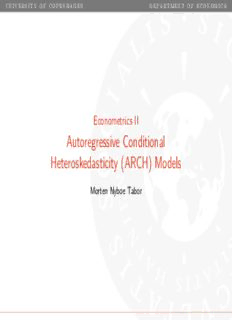Table Of Contentuniversity of copenhagen department of economics
Econometrics II
Autoregressive Conditional
Heteroskedasticity (ARCH) Models
Morten Nyboe Tabor
university of copenhagen department of economics
Learning Outcomes
After completing this topic, you should be able to:
1 Give a precise definition and interpretation of the concept of
autoregressive conditional heteroskedasticity (ARCH).
2 Give an account of statistical models with ARCH and GARCH in financial
time series.
3 Explain the conditions for stationarity of ARCH and GARCH models.
4 Explain how to estimate the parameters in ARCH models using maximum
likelihood estimation.
5 Construct misspecification tests for no ARCH-effects.
6 Explain how ARCH models can be extended to allow for asymmetries and
explanatory variables in the conditional variance.
7 Construct forecasts of the conditional variance in ARCH and GARCH
models.
EconometricsII—ARCHModels—Slide2/49
university of copenhagen department of economics
Course Outline: ARCH Models
1 Introduction
2 ARCH Models
Definition
Properties
3 ARCH: Examples
4 Misspecification Test for No-ARCH
5 ARCH: Maximum Likelihood Estimation
6 GARCH Models
Definition
Example
7 Extensions to the Basic Model
Asymmetric ARCH Models and the News Impact Curve
(G)ARCH in Mean
8 GARCH with t-distributed innovations
9 Properties of the MLE
EconometricsII—ARCHModels—Slide3/49
1. Introduction
university of copenhagen department of economics
Introduction
• Financial economists are typically interested in both the mean and the
variance. This reflects the trade-off between return and risk.
The conditional variance is a measure of ‘unexpected variation’ = risk.
• A stylized fact for financial time series is a non-constant variance
(volatility):
“...large changes tend to be followed by large changes, of either sign, and
small changes tend to be followed by small changes.”
Mandelbrot (1963).
Known as volatility clustering. ”Risk is time-varying.”
• ARCH and GARCH models are approaches to modelling this feature.
Specify equations for the conditional mean and the conditional variance.
• In a broader perspective, non-linear time series models (such as
ARCH/GARCH) are typically needed for the study of economic and
financial time series.
EconometricsII—ARCHModels—Slide5/49
university of copenhagen department of economics
Example I: Price of IBM Stock
Example I: Price of IBM Stock
(A) IBM stock, percent month-on-month (B) Squared returns
25
750
0 500
250
-25
1940 1960 1980 2000 1940 1960 1980 2000
(C) ACF - Returns (D) ACF - Squared returns
1.0 1.00
0.5 0.75
0.0 0.50
-0.5 0.25
-1.0 0.00
0 5 10 0 5 10
6of21
EconometricsII—ARCHModels—Slide6/49
2. ARCH Models
university of copenhagen department of economics
ARCH Model Defined
• Consider an equation for the conditional mean:
y =x0θ+(cid:15) , t =1,2,...,T. (∗)
t t t
Often x contains lags of y and dummies for special features of the
t t
market.
• The ARCH model also specifies an equation for the conditional variance.
Consider the information set
I ={(cid:15) ,(cid:15) ,...}={y ,x y ,x ,...}.
t−1 t−1 t−2 t−1 t−1, t−2 t−2
Assuming that E[(cid:15) |I ]=0, we define σ2 ≡E((cid:15)2 |I ).
t t−1 t t t−1
• An ARCH(1) model uses
σ2 =$+α(cid:15)2 . (∗∗)
t t−1
To ensure that σ2 >0, we need $>0, α≥0.
t
If (cid:15)2 is high, the variance of the next shock, (cid:15) , is large.
t−1 t
EconometricsII—ARCHModels—Slide8/49
university of copenhagen department of economics
ARCH Model Defined
• The model:
y = x0θ+(cid:15) , t =1,2,...,T.
t t t
E[(cid:15) |I ] = 0
t t−1
E[(cid:15)2|I ] = $+α(cid:15)2 (=σ2)
t t−1 t−1 t
• If x ∈I , Var(y |I )=σ2.
t t−1 t t−1 t
• Conditional on I , (cid:15) ∼(0,σ2).
t−1 t t
Alternatively, we may write the model as
(cid:15) = σ z , z ∼i.i.d.(0,1),
t t t t
with z independent of I .
t t−1
EconometricsII—ARCHModels—Slide9/49
university of copenhagen department of economics
ARCH Model: Properties
• The error term is
(cid:15) = σ z , z ∼i.i.d.(0,1),
t t t t
with z independent of I . Suppose that z ∼N(0,1).
t t−1 t
• It holds that
E[(cid:15) |I ] = 0
t t−1
E[(cid:15)2|I ] = $+α(cid:15)2 (=σ2)
t t−1 t−1 t
So (cid:15) is conditionally heteroskedastic.
t
In fact, (cid:15) |I ∼N(0,σ2), so the error term is conditionally normal.
t t−1 t
• Moreover, E[(cid:15) ]=0, and if 0≤α<1,
t
$
E[(cid:15)2] = .
t 1−α
So (cid:15) is unconditionally homoskedastic!
t
Typically, the unconditional distribution of (cid:15) is heavy-tailed, i.e.
t
non-normal.
EconometricsII—ARCHModels—Slide10/49
Description:and GARCH models. Econometrics II — ARCH Models — Slide 2/49 Asymmetric ARCH Models and the News Impact Curve. (G)ARCH in Mean.

